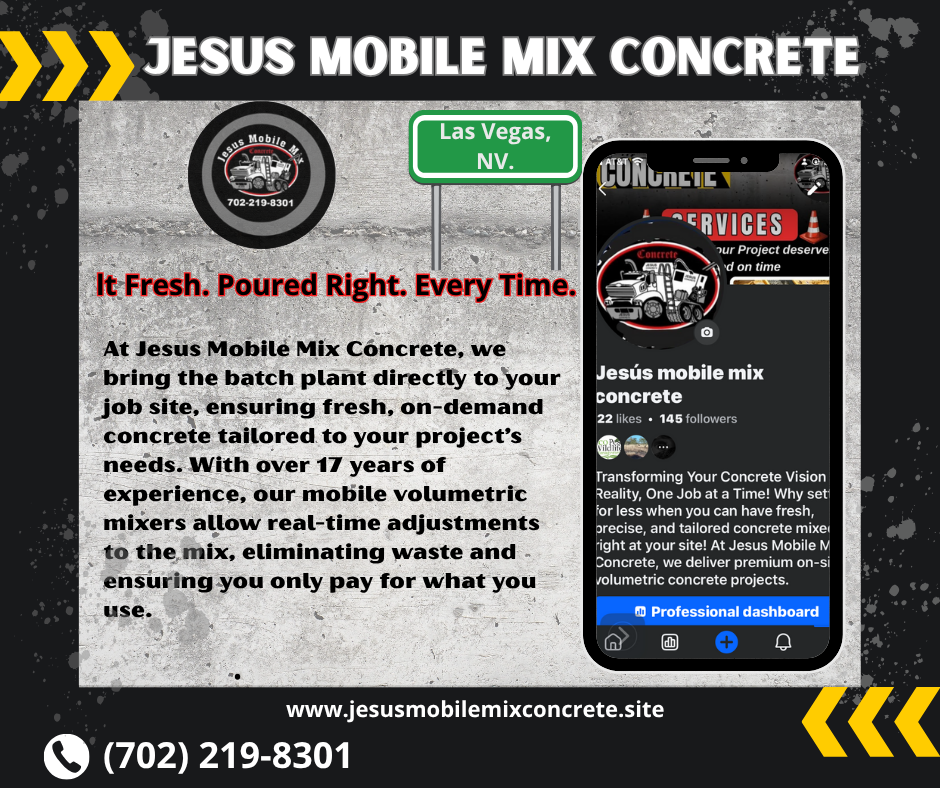Jesus Mobile Mix-Concrete Las Vegas, Nv.
The Quality of Concrete in Las Vegas: Present and Future Innovations
Concrete Performance in Las Vegas Construction In large-scale projects like CityCenter Las Vegas, concrete is engineered to reach strengths between 5,000 and 10,000 psi, thanks to advanced mix designs incorporating fly ash and superplasticizers. These additives enhance workability, reduce water content, and allow for a higher slump (up to 9”)—crucial in reinforced structures with dense rebar. Quality control is meticulous, with strength tests conducted at both the truck and pour site to ensure compliance with strict structural and aesthetic standards.
JMMC
6/17/20252 min read


Contenido de mi publicación
Challenges of the Desert Climate
Las Vegas’ intense heat and dry environment present a unique set of challenges for concrete. Rapid curing caused by high temperatures can lead to premature cracking, while extreme temperature shifts test the thermal durability of the material. Moreover, maintaining adequate moisture becomes critical, particularly for horizontal surfaces like patios and walkways, where evaporation is accelerated. To address these issues, concrete mixes in the region often incorporate moisture-retaining compounds and additives designed to reduce permeability, helping the concrete withstand the desert’s harsh conditions.
New Additives and Smart Concrete Technologies
Advancements in concrete chemistry are reshaping how we build, especially in challenging environments like Las Vegas. Chemical admixtures, such as PCE-based superplasticizers, improve flowability without additional water, making high-performance concrete more workable and consistent. Air-entraining agents and superabsorbent polymers (SAPs) are also used to introduce microbubbles or gel-like voids that help reduce shrinkage and improve thermal resistance.
Supplementary cementitious materials (SCMs) like fly ash, slag, and silica fume are widely adopted for their dual benefit of enhancing strength and lowering the carbon footprint by partially replacing traditional cement. Nano-silica particles are another innovation that densify the concrete matrix, further boosting strength and durability while optimizing material usage.
Emerging technologies are pushing the boundaries even further. Self-healing concrete, for instance, employs SAPs or specially engineered bacteria to automatically seal cracks by forming calcium carbonate. Additionally, low-carbon cement blends—particularly Portland-limestone cement (Type IL) paired with accelerators like Master X‑Seed—are enabling more sustainable construction without compromising on performance.
3D Printing and the Future of Construction
Concrete 3D printing is fast becoming a game changer in the industry. This technology allows builders to create complex architectural forms while eliminating traditional formwork and minimizing material waste. To make this possible, specialized concrete mixes are developed that offer the right balance between extrudability and structural integrity. These blends often include SCMs, fiber reinforcements, and highly engineered plasticizers, enabling innovative designs and faster build times with less environmental impact.
Industry Insights from World of Concrete Las Vegas
Las Vegas is not just a user of cutting-edge concrete technology—it’s a global stage for it. Every January, the World of Concrete Expo gathers the brightest minds in the industry to unveil and discuss the latest breakthroughs. Innovations showcased include eco-friendly admixtures like Plastol RX‑10, fiber-reinforced formulations that boost tensile strength, and data-driven systems for real-time monitoring of concrete performance. This annual event sets the tone for the next generation of sustainable, high-performance concrete solutions.
Conclusion: Building Smarter in the Desert
Far from merely adapting to desert conditions, Las Vegas is pioneering a smarter, more sustainable future in construction. The region is embracing high-strength, climate-tailored concrete mixes, integrating advanced additives that enhance durability and efficiency, and leading the adoption of tech-forward tools like 3D printing. These innovations aren’t just about building better—they’re about building responsibly, with resilience and sustainability at the core of every structure.





